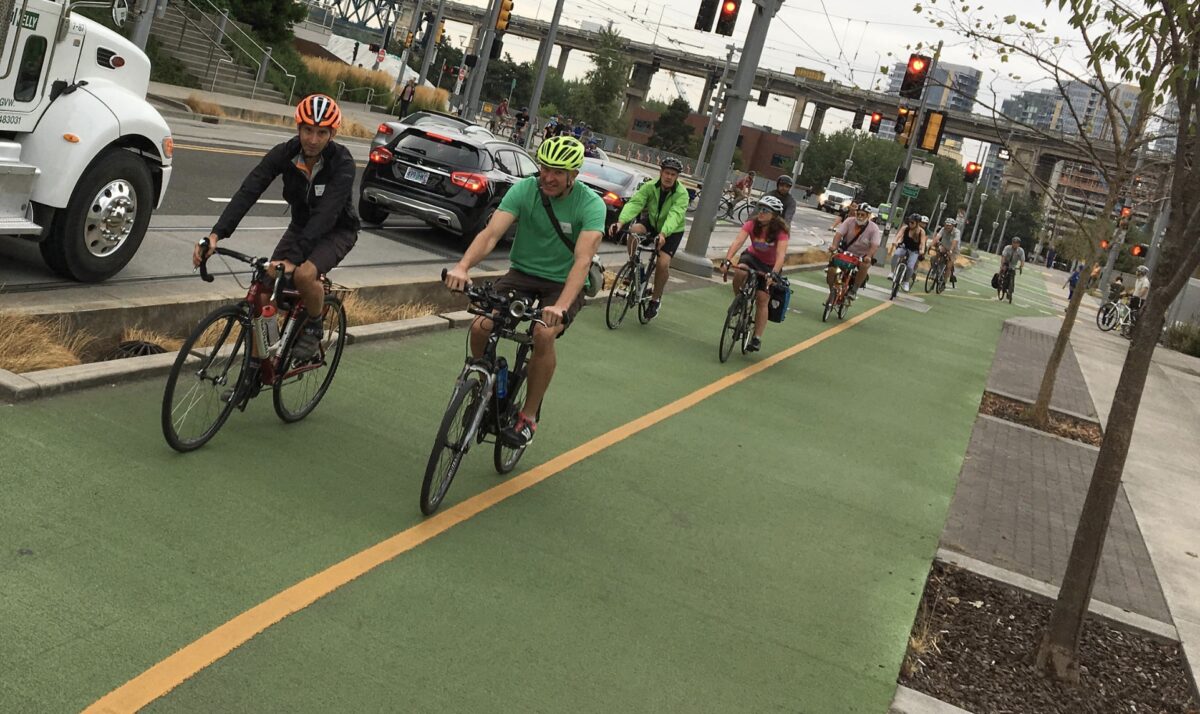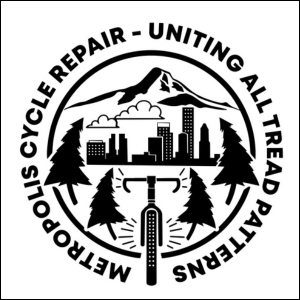
(Photo: Jonathan Maus)
Story by Lisa Caballero
For many Portlanders who care about transportation, the initial euphoria over the American Jobs Plan which will, “invest in America in a way we have not invested since we built the interstate highways and won the Space Race” was soon joined by a gnawing anxiety: How would the money be spent locally?
Area residents just voted down Metro’s $5 billion regional transportation plan, Get Moving 2020, of which the big ticket item was a MAX line to Tigard; Activists successfully fought the Columbia River Crossing; Two current projects, the Interstate Bridge Replacement Program and the I-5 Rose Quarter Project, are controversial.
Suffice it to say there’s more than a tire width of space between the people who control big capital project lists and their constituents. Deciding which projects Portland, Metro and TriMet should put forward in the competition for infrastructure dollars could size up to being the mother of all battles. An article in the New York Times Friday addressed that problem:
Advertisement
Another challenge will be ensuring that funding goes to the most effective projects. “When a lot of money is raining down from the top, states and localities will do whatever they can to get that money,” said Paul Lewis, vice president for policy and finance at the Eno Center for Transportation, a nonpartisan research center in Washington. “Sometimes, that money may go to projects that aren’t the best projects.”
Mr. Lewis noted that improving the nation’s transportation system isn’t always a question of laying down new cement and steel. Often, the most effective changes may be operational, such as charging people more to drive during rush hour to alleviate congestion, lowering speed limits to improve traffic safety or increasing the frequency of bus routes to make them more useful to riders.
Advertisement
“Words cannot describe my joy, my excitement with the Biden infrastructure announcement.”
— Earl Blumenauer, U.S. Congressman
Other policy experts have also questioned the return-on-investment of big cement and steel infrastructure projects, including economist Kenneth Rogoff, who wrote that,
an ill-considered infrastructure investment might create longer-term costs, from environmental damage to excessive maintenance requirements. The case for increasing infrastructure spending in today’s low-interest-rate environment is still compelling, but considerable technocratic expertise will be needed to help compare projects and give realistic cost assessments.
He also noted that navigating environmental concerns, right-of-way issues and “objections from apprehensive citizens representing a variety of interests” are often the biggest obstacles to new infrastructure in advanced economies.
Another framing of “objections from apprehensive citizens” might be that the projects don’t align with a community’s needs and values. States tend to spend federal highway funding on demand-inducing new roads and expansion of old ones, despite the fact that the greater need is for repair and maintenance of our many roads and bridges which are in poor condition. This is an obvious problem in Portland.
Just today Eugene Congressman Peter DeFazio, who is chairman of the House Transportation and Infrastructure Committee, told National Public Radio that he’s actively lobbying for funds to build a new Columbia River crossing.
Luckily, Biden’s plan itself comes with a point of view. It centers spending money on repairing roads rather than expanding them. And it allocates money for reducing crashes and fatalities, particularly for vulnerable road users.
Portland Congressman Earl Blumenauer was positively giddy in a long email to constituents last Friday. “Words cannot describe my joy, my excitement with the Biden infrastructure announcement,” he shared, referring to bikeways as “essential infrastructure”. “Our current infrastructure is a trap. Road deaths continue to be unacceptably high, particularly in underserved communities and for children, older adults, pedestrians, and cyclists.”
Hopefully Blumenauer’s values influence local decision-making. Portland does not lack for projects or for well-thought-out plans, but it needs bold direction.
If climate change is a priority — and it is in Biden’s plan — nothing reduces carbon, increases health and builds community like bike infrastructure. A study that came out last week in PNAS (the Proceedings of the National Academy of Sciences, one of the most prestigious scientific journals in the world) with the impressive title of Provisional COVID-19 infrastructure induces large, rapid increases in cycling, showed a correlation between increased cycling infrastructure and increases in cycling. What is noteworthy about the research is that the pandemic, and the speedy roll out of pop-up bike lanes in response to it, provided a good set of conditions for a natural experiment. The authors “scraped daily bicycles counts from 736 bicycle counters in 106 European cities” and the nearly random roll-out of the pop-ups due to administrative and construction idiosyncrasies allowed them to address concerns of reverse causality and the degree of local “green” culture.
Biden’s plan is in its early stages and still has to get through a stubborn Senate. If and when it passes, bicycle infrastructure deserves a leading role.

— Lisa Caballero, lisacaballero853@gmail.com
— Get our headlines delivered to your inbox.
— Support this independent community media outlet with a one-time contribution or monthly subscription.


